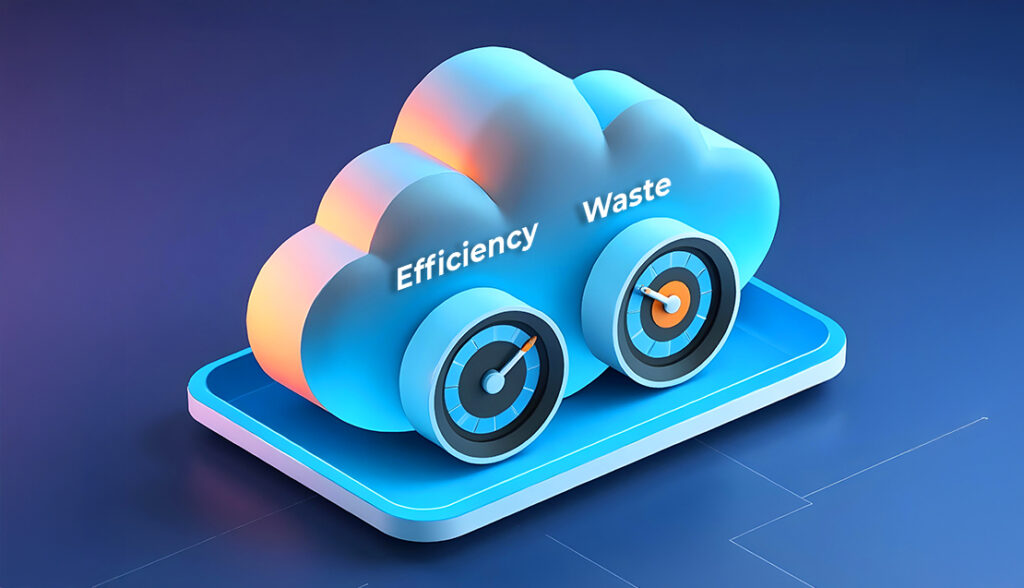As organizations expand their digital footprint in the cloud, the financial impact has become increasingly significant. Cloud computing has revolutionized how businesses operate, providing unprecedented scalability and flexibility. However, this convenience introduces a new level of financial complexity that many businesses find difficult to manage.
Cloud spending is no longer a minor line item—it now represents a substantial operational expense. As cloud adoption accelerates and workloads grow, so does the risk of uncontrolled and escalating costs. Without a strategic, proactive approach, organizations can quickly face unexpected bills that erode profitability and limit investment in innovation.
Cloud spending trends for 2025
Industry reports consistently highlight the upward trajectory of cloud expenditure. Gartner forecasts worldwide end-user spending on public cloud services to reach nearly $723 billion in 2025, and this trend is projected to continue well into 2026 and beyond.
This surge is driven by factors like increased data generation, the adoption of advanced technologies like AI and machine learning, and the ongoing migration of workloads to the cloud. However, alongside this growth comes the pressing need for cloud cost optimization and more sophisticated cloud cost management practices. Understanding these trends underscores the urgency for effective cloud cost management.
The hidden costs of inefficient cloud usage
Many organizations are unaware of the extent of their cloud waste. Research indicates that approximately 30% of cloud spend is wasted on unused or underutilized resources. This inefficiency stems from various factors, including overprovisioned resources, idle instances, and inappropriate storage tier selection. Without proper cloud cost efficiency measures, organizations risk diminishing their return on cloud investments and compromising their competitive edge.
Beyond the obvious monthly bill, inefficient cloud spending can introduce a range of hidden costs. These include:
- Missed opportunities: Overspending on the cloud can divert funds from strategic initiatives and innovation.
- Reduced profitability: Inflated cloud costs directly impact the bottom line, thus eroding profit margins.
- Budget overruns: Unpredictable cloud bills can lead to significant budget deviations, making financial planning challenging.
- Strained resources: Managing unexpected cloud costs can consume valuable time and effort from IT and finance teams.
- Slower growth: Limited resources due to overspending can hinder a company’s ability to scale and expand.
Cloud cost optimization isn’t just about saving money; it’s about maximizing the value derived from your cloud investments. By implementing effective strategies, businesses can achieve a higher return on investment (ROI) while maintaining the performance and reliability they need. It’s about working smarter, not just spending less.
Understanding cloud cost optimization
Cloud cost optimization involves implementing strategies, practices, and tools to maximize cloud value while minimizing unnecessary expenditure. It involves implementing strategies and best practices to ensure that organizations are only paying for the resources they actually need and use, without compromising performance, security, or scalability.
Defining efficient cloud resource management
Efficient cloud resource management is all about striking the right balance between cost and performance. It includes the continuous monitoring, adjustment, and governance of cloud environments to ensure optimal performance at the lowest possible cost. This includes right-sizing instances, implementing auto-scaling, utilizing reserved capacity, and selecting appropriate storage tiers based on access patterns and data criticality. Cloud efficiency aims to avoid both underutilization and overutilization.
Common cloud waste patterns to identify immediately
Identifying where your cloud spending is going is the first crucial step in optimization. Several patterns consistently contribute to unnecessary cloud expenditure, they are:
- Idle resources: Virtual machines, databases, or load balancers that are running but not actively serving any traffic or performing computations.
- Overprovisioning resources: Instances or services that have been configured with more capacity (CPU, memory, storage, bandwidth) than they actually require. You’re paying for horsepower you’re not using.
- Inappropriate instance types: Using premium instance types for non-critical workloads.
- Orphaned resources: Resources that were created for a specific purpose but were not properly decommissioned after that purpose ended. These remaining resources continue to incur costs without providing any value.
- Unattached storage volumes: Storage volumes that are provisioned but not associated with any running instances.
- Underutilized reserved instances: If reserved instances (discounted capacity purchased in advance) are not fully utilized, the potential cost savings are lost.
- Inefficient storage management: Storing infrequently accessed data on expensive, high-performance storage tiers.
- Lack of tagging and visibility: Without proper tagging, it’s difficult to understand which teams, projects, or applications are driving cloud costs, hindering effective cost allocation and accountability.
Identifying these patterns is the first step towards implementing effective cloud waste reduction strategies and the role of cloud cost optimization services and tools is paramount in tackling these challenges.
Identifying cloud waste: where businesses lose money
Pinpointing the specific areas where cloud spending is inefficient is crucial for effective optimization. Understanding the common culprits of cloud waste empowers businesses to take targeted action and realize significant savings.
Visibility as the foundation of cost control
Comprehensive visibility into cloud resources and their associated costs provides the foundation for any successful cloud cost optimization initiative. Before any optimization can occur, organizations need a clear and comprehensive view of their cloud usage and spending. This involves gaining insights into:
- Resource consumption: Tracking the utilization of compute instances, storage, databases, networking, and other cloud services.
- Cost allocation: Understanding which departments, projects, or applications are responsible for specific cloud costs.
- Spending trends: Analyzing historical data to identify patterns, anomalies, and areas of increasing expenditure.
Without this visibility, businesses are operating in the dark, making it impossible to identify and address inefficiencies effectively.
Implementing comprehensive tagging for cost allocation
Tagging (or labeling) cloud resources allows organizations to categorize and track costs by business unit, project, environment, or other relevant dimensions. This granular visibility enables more accurate cost allocation and highlights opportunities for optimization. Effective tagging strategies include:
- Mandatory tagging policies for all resources
- Automated tag enforcement
- Regular tag compliance audits
- Standardized tagging nomenclature across cloud platforms
Consistent and comprehensive tagging enables accurate cost allocation, detailed reporting, and the implementation of cost-based policies and controls.
Setting up effective monitoring and alerting systems
Proactive real-time monitoring and alerting are essential components of cloud cost management. By setting up alerts for predefined thresholds and notification systems, businesses can be notified of:
- Unexpected spikes in usage: Identifying potential anomalies or runaway costs.
- Underutilized resources: Highlighting opportunities for right-sizing or decommissioning.
- Budget exceedances: Triggering alerts when spending approaches or exceeds allocated budgets.
Effective monitoring and alerting empower teams to take timely action, preventing minor inefficiencies from escalating into significant cost overruns.
Proven strategies for cloud cost optimization
Once cloud waste is identified, a range of proven strategies can be implemented to optimize spending and improve efficiency. Implementing structured strategies for cloud waste reduction can yield substantial cost savings without compromising operational efficiency or application performance.
Resource right-sizing: The cornerstone of cost efficiency
Right-sizing involves cloud resource optimization, that is, adjusting the capacity of cloud resources like VM instance types, database sizes, storage volumes etc,. to match actual workload requirements. Over-provisioning is a common source of waste, where resources are allocated with more capacity than needed. Right-sizing ensures that you are paying for the resources you actually consume and should be an ongoing process in the organization. This often involves:
- Analyzing historical utilization data: Identifying periods of peak and low demand.
- Monitoring real-time performance metrics: Understanding current resource needs.
- Choosing instance types and sizes that align with workload characteristics: Selecting the most cost-effective options.
- Regularly reviewing and adjusting resource configurations: Adapting to changing workload demands.
Implementing auto-scaling: Dynamically adjusting resources
Auto-scaling automatically adjusts the number of compute instances or the capacity of other resources based on real-time demand. This eliminates the need to manually provision for peak loads, ensuring optimal performance during high-traffic periods while automatically scaling down during low-traffic periods to reduce costs. Implementing auto-scaling requires:
- Defining scaling policies: Specifying the conditions under which scaling up or down should occur.
- Setting performance metrics: Identifying the indicators that trigger scaling events (e.g., CPU utilization, network traffic).
- Testing scaling configurations: Ensuring that the auto-scaling mechanism functions correctly.
Leveraging reserved & spot instances: Maximizing cost savings
Cloud providers offer different pricing models, and leveraging discounted options like reserved instances and spot instances can lead to significant cost savings:
- Reserved Instances (RIs) or Savings Plans: These offer discounted hourly rates (up to 75% off on-demand prices) in exchange for a commitment to a specific instance type and region for a one- or three-year term. RIs are ideal for predictable, long-running workloads.
- Spot Instances: These offer significant discounts (up to 90% off on-demand prices) for unused EC2 capacity. However, spot instances can be interrupted with little notice, making them suitable for fault-tolerant, non-critical workloads.
Strategic planning and careful consideration of workload characteristics are crucial for effectively utilizing these pricing models.
Implementing intelligent scheduling for non-production environments
Development, testing, and staging environments often don’t require 24/7 availability. Implementing scheduling to automatically start these resources when needed and shut them down during off-hours (nights, weekends) can generate substantial cost savings. This can be achieved through native cloud provider tools or third-party automation solutions.
Storage optimization strategies for different data types
Data storage costs can account for a significant portion of cloud bills. Cloud storage comes in various tiers with different performance characteristics and pricing. Optimizing storage costs involves:
- Classifying data based on access frequency: Identifying hot (frequently accessed), warm (less frequently accessed), and cold (rarely accessed) data.
- Tiering data appropriately: Moving less frequently accessed data to lower-cost storage tiers.
- Implementing lifecycle policies: Automating the movement of data between storage tiers based on predefined rules.
- Deleting obsolete data: Regularly identifying and removing data that is no longer needed.
- Compressing data: Compress data where appropriate.
- Deduplication: Regularly identify redundant and duplicate data entities and run periodic deduplication on redundant information.
Reducing costly data transfer inefficiencies
Data transfer costs can become significant, especially for applications that involve moving large amounts of data between cloud regions and egress traffic. Strategies to minimize these costs include:
- Co-locating resources: Deploying resources in the same availability zone or region to reduce inter-region transfer fees.
- Content Delivery Networks: Use content delivery networks (CDNs) for frequently accessed content
- Optimizing data transfer protocols: Using efficient protocols and compression techniques.
- Caching frequently accessed data: Reducing the need to repeatedly transfer data.
- Utilizing edge computing: Processing data closer to the source to minimize the amount of data that needs to be transferred to the cloud.
Using cloud cost optimization tools to gain real-time insights
A variety of cloud cost optimization tools, both native to cloud providers and offered by third-party vendors, provide real-time insights into cloud spending, identify cost-saving opportunities, and automate optimization tasks.
Cloud cost optimization tools: must-have solutions for cost management
Cloud cost optimization tools are essential for gaining visibility into cloud spending, identifying areas of waste, and automating cost-saving measures. They provide valuable insights and capabilities that simplify the complex task of managing cloud expenses.
Pay less for what you use: discount mechanisms
Cloud providers offer various purchasing options that can substantially reduce costs compared to on-demand pricing.
Reserved instances and savings plans: When and how to implement
Reserved Instances (RIs) and Savings Plans allow organizations to commit to specific usage levels in exchange for substantial discounts, often 40-70% below on-demand rates. Effective implementation requires:
- Analyzing stable, predictable workloads for commitment opportunities
- Balancing commitment term length against discount percentage
- Regularly reviewing and adjusting commitments as workloads evolve
- Implementing a centralized process for managing commitments across the organization
Leveraging spot instances for non-critical workloads
Spot instances (or preemptible VMs) offer discounts of up to 90% for interruptible capacity. These instances are ideal for fault-tolerant, flexible workloads such as batch processing, data analysis, and containerized applications. Implementing spot instances requires:
- Identifying interruptible workloads
- Designing for resilience to instance termination
- Implementing automated bidding and instance management
- Using spot instance orchestration tools to maximize availability and savings
Negotiating enterprise agreements for maximum savings
Organizations with significant cloud spending should explore enterprise agreements with their providers. These customized contracts often include:
- Volume-based discounts
- Reserved capacity commitments with flexible terms
- Credits for migration or proof-of-concept projects
- Technical support and architectural guidance
Cloud cost optimization tool comparison
A growing ecosystem of tools is available to help organizations implement and maintain cloud cost efficiency.
Native cloud provider tools and their limitations
Major cloud providers offer their own cost management tools:
- AWS Cost Explorer: Provides detailed cost and usage reports, cost forecasting, and recommendations for cost optimization.
- Google Cloud Cost Management: Offers cost reporting, analysis, budgeting, and recommendations through its Cloud Billing console.
- Azure Cost Management: Provides tools for monitoring, allocating, and optimizing Azure spending.
These tools provide valuable insights into spending patterns and offer basic optimization recommendations. However, they typically have limitations compared to specialized solutions, including:
- Limited cross-cloud visibility for multi-cloud environments
- Basic recommendation engines compared to specialized solutions
- Less granular reporting capabilities
- Fewer automation options for implementing recommendations
Third-party solutions for advanced optimization
A range of third-party cloud cost optimization tools offer more advanced features and capabilities, often supporting multiple cloud platforms:
- CloudHealth (by VMware): Provides comprehensive visibility, governance, and optimization recommendations across multi-cloud environments.
- Spot.io (by NetApp): Focuses on automated cost optimization for compute resources, leveraging spot instances and predictive analytics.
- nOps: Offers AI-powered cloud cost management and optimization for AWS.
- Apptio Cloudability: Provides detailed cost analytics, budgeting, and forecasting across hybrid and multi-cloud environments.
These tools often offer:
- Enhanced visibility: Consolidated views of spending across multiple clouds.
- Advanced analytics: Deeper insights into cost drivers and trends.
- Automated optimization: Features like automated right-sizing and spot instance management.
- FinOps integrated: Integration with financial systems and FinOps frameworks
- Customizable reporting: Tailored reports for different stakeholders.
- Policy enforcement: Setting and enforcing cost governance rules.
The choice between native and third-party tools depends on the complexity of your cloud environment, the depth of insights required, and the level of automation desired. Companies like Naviteq help you make smart decisions in choosing and setting up the perfect tools best suited for your organization. Naviteq’s team of cloud experts, with years of experience in the field, helps you make the best decisions for optimum cloud cost optimization.
Best practices for ongoing cloud cost management
Cloud cost optimization is not a one-time project but an ongoing process that requires establishing best practices and fostering a cost-conscious culture within the organization.
Building a cloud cost optimization culture with FinOps
Sustainable cloud cost optimization requires more than tools, it demands organizational alignment and a culture of cost awareness. FinOps, or Cloud Financial Operations, is a cultural practice that brings financial accountability to cloud spending. It involves collaboration between finance, IT, and DevOps teams to make informed decisions about cloud costs, maximize value, and drive financial accountability. FinOps implementation involves:
- Transparency: Providing clear visibility into cloud costs for all relevant teams.
- Accountability: Assigning ownership for cloud spending to specific teams or individuals.
- Centralized governance: Establishing policies and processes for managing cloud costs effectively.
- Continuous optimization: Regularly reviewing and optimizing cloud spending.
Cross-functional collaboration between Finance, IT, and DevOps
Effective cloud cost management requires close collaboration between different teams. Finance provides budget oversight and cost analysis, IT manages the infrastructure and resources, and DevOps focuses on application deployment and performance. By working together, these teams can:
- Align cloud spending with business goals.
- Develop and implement cost-saving strategies.
- Ensure financial accountability for cloud usage.
- Optimize resource utilization without impacting performance.
- Understand the technical context of cloud spending
- Appreciate the business impact of their resource decisions
- Business units maintain visibility into the costs of their cloud initiatives
Implementing FinOps principles helps organizations transition from reactive cost management to proactive cloud cost efficiency.
Implementing continuous optimization practices
Cloud cost optimization isn’t a one-time project but an ongoing process. The cloud environment is dynamic, with changing workloads, new services, and evolving pricing models. Therefore, continuous monitoring, analysis, and optimization are crucial. Continuous optimization practices include:
- Regularly cost reviews and usage reports
- Identifying new opportunities for savings
- Automated policy enforcement for resource deployment
- Adapting optimization strategies to changing needs
- Automating optimization tasks where possible
- Integration of cost considerations into CI/CD pipelines
By making cloud cost optimization an ongoing priority, businesses can ensure they are consistently maximizing the value of their cloud investments.
When to seek expert help?
While tools provide valuable data and automation, sometimes expert guidance is needed to develop and implement a comprehensive cloud cost optimization strategy. Cloud cost optimization services offer specialized knowledge and experience to help businesses achieve significant savings.
The Naviteq approach to cloud cost optimization
Specialized cloud cost optimization services like Naviteq provide comprehensive approaches to identifying and capturing savings opportunities. This often involves:
- Expert cost audits and assessments: Analyzing current cloud usage and spending patterns to identify areas of inefficiency and potential savings.
- Continuous monitoring and performance tuning: Proactively tracking resource utilization and making adjustments to optimize both cost and performance.
- Customized cloud savings strategies: Developing tailored recommendations based on the specific needs and environment of the business.
- Implementation support: Assisting with the implementation of optimization strategies and the configuration of cost management tools.
Our proven methodology for identifying savings opportunities
Naviteq provides effective cloud cost optimization services that typically follow a structured methodology. This methodology includes steps like:
- Discovery and analysis: Gathering data on cloud usage, spending, and performance.
- Identification of waste: Pinpointing areas of underutilization, over-provisioning, and inefficient configurations.
- Strategy development: Creating a customized plan with specific recommendations and actionable steps.
- Implementation and optimization: Implementation of the organizational and technical changes to increase savings and continuously tuning the environment.
- Monitoring and reporting: Providing ongoing visibility into cloud costs and the impact of optimization efforts.
- Governance: Establishing policies and procedures to maintain optimization over time.
Professional services complement internal efforts and cloud cost optimization tools, providing expertise and accelerating the journey to optimal cloud spending.
Benefits of using Naviteq’s cloud cost optimization services
Using Naviteq’s cloud cost optimization services can provide several benefits such as:
- Expertise and experience: Access to specialized knowledge and proven methodologies.
- Time savings: Freeing up internal teams to focus on core business activities.
- Faster results: Quickly identifying and implementing cost-saving measures.
- Objective perspective: An unbiased assessment of cloud spending.
- Ongoing support: Continuous monitoring and optimization to ensure sustained savings.
Naviteq’s managed cloud cost optimization services can be particularly valuable for businesses with complex cloud environments or those lacking in-house expertise of time commitment in this area. We can help organizations scale their cloud usage effectively while keeping costs under control.
Future trends in cloud cost management
The field of cloud cost management is constantly evolving, driven by advancements in technology and the increasing complexity of cloud environments.
AI-driven optimization becoming the standard
Artificial intelligence (AI) and machine learning (ML) are playing an increasingly significant role in cloud cost optimization. AI-powered tools can analyze vast amounts of data to identify patterns, predict future spending, and automate optimization tasks with greater accuracy and efficiency than manual approaches. It is expected to see more sophisticated AI-driven recommendations for resource right-sizing, scheduling, and pricing model selection in the future.
AI-driven approaches enable:
- Predictive analytics for forecasting future spending
- Anomaly detection to identify unusual cost patterns
- Automated resource adjustment based on usage patterns
- Continuous learning from optimization outcomes
As these capabilities mature, organizations will benefit from increasingly automated and precise optimization recommendations.
Sustainability and cost efficiency alignment
Environmental concerns are converging with financial considerations in cloud strategy. Future cloud cost optimization will increasingly account for carbon footprint alongside dollar expenditure. Sustainability is becoming a growing concern for businesses, and cloud computing is no exception. Future trends in cloud cost management will likely see a greater alignment between cost optimization and environmental sustainability. Optimizing resource utilization not only reduces costs but also lowers energy consumption and carbon emissions. Cloud providers are already offering tools to measure and reduce the environmental impact of cloud workloads, creating opportunities to align sustainability goals with cost-saving initiatives.
Making cloud cost optimization a priority
Cloud cost optimization is no longer optional for organizations seeking to maximize their return on cloud investments. By implementing proven strategies, utilizing effective tools and embracing FinOps principles, organizations can significantly reduce cloud costs, improve efficiency, and maximize the value derived from their cloud investments.
Recap of key strategies, tools, and services
The key strategies explored in this blog that have explored various aspects of cloud cost optimization, including:
- Understanding the fundamentals of cloud cost management.
- Identifying common patterns of cloud waste.
- Implementing strategic approaches like right-sizing, auto-scaling, and leveraging discounted pricing models.
- Utilizing native and third-party cloud cost optimization tools.
- Establishing best practices for ongoing cost management through FinOps and cross-functional collaboration.
- Recognizing when to seek expert help from cloud cost optimization services.
- Considering future trends like AI-driven optimization and the alignment of cost.
By making cost optimization an ongoing priority rather than a reactive response to budget overruns, organizations can transform their cloud environments from potential sources of waste to engines of efficient innovation. Whether through internal initiatives or specialized cloud cost optimization services, the journey toward optimal cloud spending begins with visibility, continues through strategic implementation, and sustains through organizational commitment.
The cloud offers unprecedented opportunities for innovation and growth but only organizations that manage their cloud resources efficiently will fully realize these benefits. Start your cloud cost optimization journey today by assessing your current spending patterns, identifying waste, and implementing the strategies that align best with your organizational goals.
Ready to start a cloud cost optimization journey?
Contact Naviteq today to discover how you can optimize your cloud costs. Our team of AWS-certified experts will help you develop and implement a customized cloud cost optimization strategy aligned with your business objectives.
Frequently Asked Questions
What is cloud cost optimization?
Cloud cost optimization is the practice of managing and reducing cloud spending while maintaining or improving performance. It involves identifying waste, right-sizing resources, using automation, and applying purchasing strategies like reserved instances or spot instances. The goal is to maximize the value of every dollar spent in the cloud.
How much can organizations typically save through cloud cost optimization?
Organizations implementing comprehensive cloud cost optimization strategies typically reduce their cloud spending by 20–35%, with some achieving savings of up to 50% in specific areas like non-production environments.
Is cloud cost optimization primarily about reducing spending?
While cost reduction is a key benefit, cloud cost optimization is equally focused on maximizing value by ensuring resources align with business requirements. The goal is efficient spending rather than simply spending less.
How often should we review our cloud costs?
Cloud cost management should be continuous, with automated monitoring and alerts. Dedicated optimization reviews should occur at least monthly, with more comprehensive assessments quarterly.
How can cloud computing reduce costs for a business?
Cloud computing can reduce costs by eliminating the need for large capital investments in on-premise infrastructure, offering pay-as-you-go pricing, and enabling elastic scaling so you only pay for what you use. Without active management, however, costs can rise quickly — making optimization essential.
What are the key areas of cloud cost optimization?
The blog highlights several key areas:
Right-sizing resources to match workload needs
Implementing auto-scaling for demand fluctuations
Optimizing storage tiers based on data access frequency
Reducing data transfer costs through co-location and caching
Leveraging cost optimization tools for visibility and automation
Applying FinOps principles to align financial accountability with technical decisions
How do we balance cost optimization with performance and reliability?
Effective cloud cost efficiency strategies maintain or enhance performance while reducing waste. This is achieved through right-sizing rather than downsizing and by implementing proper auto-scaling policies that adapt to changing demand.
How can you optimize costs in AWS?
AWS offers native tools like Cost Explorer, Trusted Advisor, and Compute Optimizer to identify savings opportunities. Common tactics include using Savings Plans or Reserved Instances for predictable workloads, leveraging spot instances for fault-tolerant jobs, and enabling auto-scaling to match demand.
How can you manage cloud costs in Azure?
Azure provides tools like Azure Cost Management + Billing for tracking and analyzing spend. Organizations can use Azure Reservations, Spot VMs, and auto-shutdown schedules for dev/test environments to reduce costs, combined with tagging and budgeting for cost visibility.
Why is cloud cost management challenging?
Cloud cost management is difficult because pricing models are complex, workloads change frequently, and costs are often spread across multiple services and teams. In multi-cloud or hybrid environments, tracking and controlling spend requires unified visibility and standardized policies.
How can you cut cloud costs without hurting performance?
Focus on right-sizing rather than downsizing, use auto-scaling to adapt capacity in real time, move infrequently accessed data to lower-cost storage tiers, and implement intelligent scheduling for non-production environments. This keeps performance intact while removing waste.
Should we implement cloud cost optimization internally or use external services?
Many organizations benefit from a hybrid approach, developing internal capabilities while leveraging specialized cloud cost optimization services for initial assessments, strategy development, and periodic expert reviews.
What is cost efficiency in cloud computing?
Cost efficiency means achieving the best possible performance, scalability, and security for the lowest necessary spend. It’s about aligning resources with workload requirements and eliminating waste — not just spending less.
How are cloud costs calculated?
Cloud costs are typically calculated based on resource usage, including compute hours, storage consumed, data transfer, and additional services like databases or load balancers. Pricing varies by service, region, and commitment model, which makes visibility and tracking crucial.






